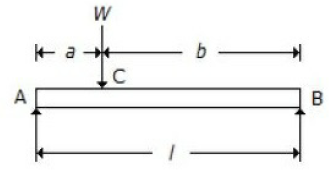When a body is subjected to biaxial stress i.e. direct stresses (σx) and (σy) in two mutually perpendicular planes accompanied by a simple shear stress (τxy), then minimum normal stress is
(σx + σy)/2 + (1/2) × √[(σx - σy)² + 4 τ²xy]
(σx + σy)/2 - (1/2) × √[(σx - σy)² + 4 τ²xy]
(σx - σy)/2 + (1/2) × √[(σx + σy)² + 4 τ²xy]
(σx - σy)/2 - (1/2) × √[(σx + σy)² + 4 τ²xy]
Correct Answer :
B. (σx + σy)/2 - (1/2) × √[(σx - σy)² + 4 τ²xy]
Related Questions
Those substances which have so far not been resolved by any means into other substances of simpler form are called
Elements
Compounds
Atoms
Molecules
Brayton cycle consists' of following four processes
Two isothermals and two isentropic
Two isentropic and two constant volumes
Two isentropic, one constant volume and one constant pressure
Two isentropic and two constant pressures
Kelvin-Planck's law deals with
Conservation of work
Conservation of heat
Conversion of heat into work
Conversion of work into heat
A composite bar made up of steel and copper bars of equal lengths are heated through 100°C. The stresses developed shall be
Tensile in both the material
Tensile in steel and compressive in copper
Compressive in steel and tensile in copper
Compressive in both the materials
Which of the following is the correct statement?
For a given compression ratio, both Otto and Diesel cycles have the same efficiency.
For a given compression ratio, Otto cycle is more efficient than Diesel cycle.
For a given compression ratio, Diesel cycle is more efficient than Otto cycle.
The efficiency of Otto or Diesel cycle has nothing to do with compression ratio.
The calorific value of gaseous fuel is expressed in
kJ
kJ/kg
kJ/m2
kJ/m3
When a body is subjected to a direct tensile stress (σx) in one plane accompanied by a simple shear stress (τxy), the maximum normal stress i
(σx/2) + (1/2) × √(σx² + 4 τ²xy)
(σx/2) - (1/2) × √(σx² + 4 τ²xy)
(σx/2) + (1/2) × √(σx² - 4 τ²xy)
(1/2) × √(σx² + 4 τ²xy)
Which of the following cycles has maximum efficiency?
Rankine
Stirling
Carnot
Brayton
The __________ is obtained when carbonisation of coal is carried out at 500° to 700° C.
Soft coal
Hard coal
Pulverised coal
Bituminous coal
The rivets are used for __________ fastenings.
Permanent
Temporary
Semi-permanent
None of these
A molecule consisting of one atom is known as
Mono-atomic
Di-atomic
Tri-atomic
Poly-atomic
The efficiency of the Carnot cycle is (where T1 and T2 = Highest and lowest temperature during the cycle)
(T1/T2) - 1
1 - (T1/T2)
1 - (T2/T1)
1 + (T2/T1)
The total strain energy stored in a body is termed a
Resilience
Proof resilience
Modulus of resilience
Toughness
The __________ states that change of internal energy of a perfect gas is directly proportional to the change of temperature.
Boyle's law
Charle's law
Gay-Lussac law
Joule's law
For a beam, as shown in the below figure, the deflection at C is (where E = Young's modulus for the beam material, and I = Moment of inertia of the beam section.

Wl3/48 EI
Wa²b²/3EIl
[Wa/(a√3) x EIl] x (l² - a²)3/2
5Wl3/384 EI
The principal constituents of a fuel are
Carbon and hydrogen
Oxygen and hydrogen
Sulphur and oxygen
Sulphur and hydrogen
The bending equation is
M/I = σ/y = E/R
T/J = τ/R = Cθ/l
M/R = T/J = Cθ/l
T/l= τ/J = R/Cθ
If in the equation pvn = C, the value of n = ∝, then the process is called
Constant volume process
Adiabatic process
Constant pressure process
Isothermal process
The condition for the reversibility of a cycle is
The pressure and temperature of the working substance must not differ, appreciably, from those of the surroundings at any stage in the process
All the processes, taking place in the cycle of operation, must be extremely slow
The working parts of the engine must be friction free
All of the above
The temperature at which the volume of a gas becomes zero is called
Absolute scale of temperature
Absolute zero temperature
Absolute temperature
None of these
Which of the following is the extensive property of a thermodynamic system?
Pressure
Volume
Temperature
Density
The general law of expansion or compression is pvn = C, The process is said to be hyperbolic, if n is equal to
0
1
γ
∝
Strain energy is the
Energy stored in a body when strained within elastic limits
Energy stored in a body when strained up to the breaking of a specimen
Maximum strain energy which can be stored in a body
Proof resilience per unit volume of a material
Which of the following gas has a minimum molecular mass?
Oxygen
Nitrogen
Hydrogen
Methane
The value of one bar (in S. I. units) is equal to
1 × 102 N/m2
1 × 103 N/m2
1 × 104 N/m2
1 × 105 N/m2
In an extensive property of a thermodynamic system
Extensive heat is transferred
Extensive work is done
Extensive energy is utilised
None of these
Shear modulus is the ratio of
Linear stress to linear strain
Linear stress to lateral strain
Volumetric strain to linear strain
Shear stress to shear strain
In a prismatic member made of two materials so joined that they deform equally under axial stress, the unit stresses in two materials are
Equal
Proportional to their respective moduli of elasticity
Inversely proportional to their moduli of elasticity
Average of the sum of moduli of elasticity
The oxygen atom is ________ times heavier than the hydrogen atom.
2
8
16
32
Which of the following is a reversible non-flow process?
Isochoric process
Isobaric process
Hyperbolic process
All of these
